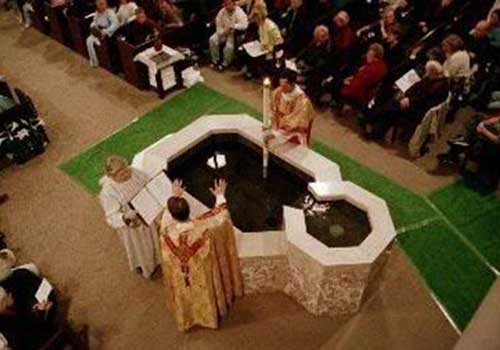We can follow the ancient tradition and announce the date of Easter on the Feast of the Epiphany. This proclamation highlights the centrality of the resurrection of Christ in the liturgical year and the importance of the great mysteries of faith which are celebrated each year.
The proclamation may occur after the Gospel, homily, or after the prayer after communion [if blessing chalk (after communion), the earlier options may be preferred so as not to clutter the conclusion of the Eucharist]. It may be sung or said, by the deacon, or other(s).
Here is a version for two lectors. It can be adapted in a number of ways – including being proclaimed by one lector.
Lector 1 stands at the Ambo, Lector 2 stands at the Cantor Lectern
Lector 1
Dear brothers and sisters, the glory of the Lord has shone upon us, and shall ever be manifest among us, until the day of his return.
Through the rhythms of times and seasons let us celebrate the mysteries of salvation.Lector 2
Let us recall the year’s culmination, the Easter Triduum of the Lord: his last supper, his crucifixion, his burial, and his rising celebrated between the evening of the seventeenth day of April and the evening of the nineteenth day of April, Easter Sunday being on the twentieth day of April.Lector 1
Each Easter — as on each Sunday — the Holy Church makes present the great and saving deed by which Christ has for ever conquered sin and death. From Easter are reckoned all the days we keep holy.Lector 2
Ash Wednesday, the beginning of Lent, will occur on the fifth day of March.Lector 1
The Ascension of the Lord will be commemorated on the twenty-ninth day of May.Lector 2
Pentecost, joyful conclusion of the season of Easter, will be celebrated on the eighth day of June.Lector 1
And, this year the First Sunday of Advent will be on the thirtieth day of November.Lector 2
Likewise the pilgrim Church proclaims the Passover of Christ in the feasts of the holy Mother of God, in the feasts of the Apostles and Saints, and in the commemoration of the faithful departed.Lector 1
To Jesus Christ, who was, who is, and who is to come, Lord of time and history, be endless praise, for ever and ever.
Amen. [Amen. Amen.]
During this Southern-Hemisphere, Aotearoa-New Zealand, go-slow season sometimes your comments may take longer than usual to get through moderation…
If you have not done so already, I encourage you to “like” the liturgy facebook page.
The image is of blessing the font at the Easter Vigil.




This is the older translation, not the translation in the newest Missal.
Is it acceptable to use this older translation? I think it is much more poetic than the current translation.
Some might be interested in an RC chant setting (last link on the page):
http://icelweb.org/musicfolder/openmusic.php
NB use Internet Explorer, not Firefox.
Thanks so much, Dennis. Blessings.
The pic with the baptism fonts is gorgeous. In fact, they make a good connection between Epiphany and Easter vigil, in both of which there’s the blessing of the water.